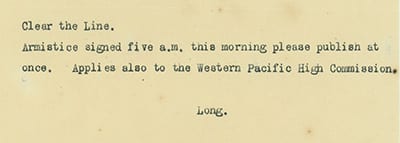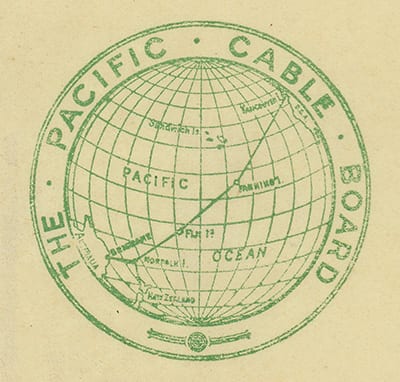
Detail of telegram from Secretary of State for the Colonies, 11 November 1918. Western Pacific Archives. MSS & Archives 2003/1, WPHC4/IV 1918, 2614/1918.
The First World War ended with the signing of an armistice between Germany and the Allied Powers in Compiegne, France at 5.30am on 11 November 1918. The message ordering hostilities to cease at 11am Paris-time was transmitted within minutes to military commanders at the front by radio and telephone.1 By the end of the day, the news had made its way by telegram to the far corners of the British Empire.
In Suva, the Governor of Fiji and Western Pacific High Commissioner Cecil Rodwell received the news from Walter Long, the London-based Secretary of State for the Colonies.2 Long’s message, pictured above, was brief and to the point and began with the words ‘Clear the Line’, indicating the content was of upmost importance. It is difficult to pinpoint the exact time that Long’s message was received in Fiji as the relevant file in the Western Pacific Archives contains a typed copy rather than the actual telegram. However, the Fiji Times reported that the news arrived in Suva shortly before 9pm local time on the 11th and celebrations began soon after.3 The High Commissioner’s secretary, A.L. Ayton, forwarded the news on the 12th to the British Agent and Consul in Tonga, the Administrator of Nauru and the Resident Commissioners in Port Vila (Vanuatu), Ocean Island (Banaba, Kiribati) and Tulagi (Solomon Islands). The Resident Commissioners replied by telegram, expressing their ‘heartfelt joy’ that the war was over.4

Pacific Cable Board logo. Western Pacific Archives. MSS & Archives 2003/1, WPHC 4/IV 1918, 2607/1918.
Long’s message was most likely transmitted from London to Suva by the Pacific Cable Board (PCB), a cooperative venture between the British, Canadian, Australian and New Zealand governments. In contrast to the eastern cable link between London and Australia via the Middle East, the PCB’s western route only crossed British-controlled territory, providing a reliable, secure and entirely British means of communication, known informally as the ‘All Red Line’.5 On this route, cable messages were transmitted from London across the Atlantic by submarine cable to Halifax on Canada’s east coast then overland by telegraphic line to Bamfield near Vancouver. From Bamfield, messages were conveyed via the Trans-Pacific Cable to Fanning Island in modern-day Kiribati and then to Suva. The PCB also operated cable links between Suva and Auckland, Suva and Norfolk Island, and Norfolk Island and Australia.
Before the invention of electronic repeaters, now a standard feature of telecommunication systems, each message or signal had to be read and manually re-transmitted by operators at each cable station. Reading cable signals required great skill, especially as the signal degraded over long distances. At more than 6000km, the cable between Bamfield and Fanning Island was the longest in the world and the signals were the hardest to read.6
Interestingly, the telegram from the Secretary of State to New Zealand’s Governor–General, Lord Liverpool, was transmitted via the Middle East by PCB’s rival the Eastern Extension A. and C. Telegraph Co Ltd, using its trans-Tasman cable which terminated in Wellington.7
The Secretary of State’s telegram to the Western Pacific High Commissioner and related items are on display until 7 December outside Special Collections on General Library Level G.
Katherine Pawley, Special Collections
References
1 Weintraub, S. (1985). A stillness heard round the world: The end of the great war, November 1918. New York: Oxford University Press.
2 From The Secretary of State… 11th November, 1918. Western Pacific Archives. MSS & Archives 2003/1, WPHC4/IV 1918, 2614/1918. Special Collections, University of Auckland Libraries and Learning Services.
3 The Fiji Times. (1969). Our first 100 years, 1869-1969: Centennial supplement. Suva: The Fiji Times.
4 From The Secretary of State… 11th November, 1918. Western Pacific Archives. MSS & Archives 2003/1, WPHC 4/IV 1918, 2601/1918; From Resident Commissioner, Gilbert and Ellice Islands… 14th November, 1918. Western Pacific Archives. MSS & Archives 2003/1, WPHC 4/IV 1918, 2607/1918.
5 Scott, R.B. (1994). Gentlemen on imperial service: A story of the Trans-Pacific Telecommunications Cable told in their own words by those who served. Victoria: Sono Nis Press.
6 ibid.
7 Ministry for Culture and Heritage. (2014). Armistice signed telegram. Retrieved from https://nzhistory.govt.nz/media/photo/armisitice-signed-telegram
